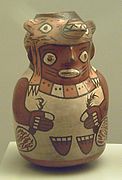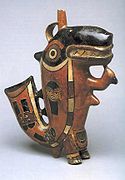Наска (культура)







Наска — доколумбова цивилизация, которая существовала в нескольких долинах на южном побережье Перу, на плато Наска, южнее цивилизации Мочика, с II в. до н. э. по VI в. н. э. Главный город — Кауачи с шестью пирамидами из самана. Произошла предположительно от культуры Паракас.
Культуре Наска нередко приписывается создание громадных геоглифов Наски, однако относительно времени их создания среди учёных нет единого мнения[1].
Культура
[править | править код]Керамика культуры Наска полихромная, как правило, четырёхцветная: чёрные и оранжевые рисунки на белом или красном фоне. Преобладают изображения людей, зверей, птиц, рыб и растений. Формы удлинённые, стилизованные и угловатые. В отличие от цивилизации мочика — лепка практически отсутствует.
Подобные узоры можно видеть и на образцах тканей из шерсти ламы, сохранившихся благодаря полупустынному климату плато. Частично уцелела и созданная ими сеть подземных акведуков.
Ткани культуры Наска
[править | править код]Выделка текстиля у культуры Наска была наиболее совершенной в древнем Перу. Ткани изготавливались по нескольким техникам, а их стили — развивались. По подсчетам ученых существует около пяти различных стилей их исполнения. До внедрения трехмерной техники шитья, первоначальный стиль текстиля напоминал ткани некрополей Паракаса.
Мумии культуры Наска
[править | править код]См. также
[править | править код]- История Перу
- Андский канделябр
- Лима (культура)
- Чавинская культура
- Чиму
- Паракас (культура)
- Тиуанако
- Моче
Литература
[править | править код]- The Incas and the Ancestors: The Archaeology of Perú. Revised Edition. By Michael E. Moseley
- Cahuachi in the Ancient Nasca World. Silverman, Helaine. University of Iowa Press. Iowa City. 1993.
- A Sourcebook of Nasca Ceramic Iconography. By Donald A. Proulx (2006) University of Iowa Press
- From Monumental to Proliferous in Nasca Pottery. By Richard Roark (1965) Nawpa Pacha 3:2
- The Nasca. By Helaine Silverman and Donald A. Proulx. Blackwell Publishers. Malden. 2002.
- Ancient Nazca Settlement and Society. By Helaine Silverman (2002) University of Iowa Press
- Local Differences and Time Differences in Nasca Pottery. By Donald A. Proulx (1968) University of California Press
- Cahuachi: New Evidence for an Early Nasca Ceremonial Role. By Lidio M. Valdez, Current Anthropology 35, no. 5 (December 1994): 675—679
- The Archaeological Identification of an Ancient Peruvian Pilgrimage Center. By Helaine Silverman, World Archaeology 26, no. 1 (June 1994): 1-18
- Ceramic Production in Ancient Nasca: Provenance Analysis of Pottery from the Early Nasca and Tiza Cultures Through INNA. By Kevin J. Vaughn, Journal of Archaeological Science (2006), Volume 33, Issue 5: 681—689
- A Compositional Perspective on the Origins of the Nasca Cult at Cahuachi. By Kevin J. Vaughn, Journal of Archaeological Science (2007), Volume 34, Issue 5:814-822
- Burial Patterns and Sociopolitical Organization in Nasca 5 Society. By William Harris and Helaine Silverman, Andean Archaeology III (2006), Volume 3:374-400
- Cahuachi: Non-Urban Cultural Complexity on the South Coast of Peru. By Helaine Silverman, Journal of Field Archaeology (1988), Volume 15, No. 4:403-430
- What the Women Were Wearing. By Mary Frame, Textile Museum Journal (2003/04), Volume 42-43:13-53
- Households, Crafts and Feasting in the Ancient Andes: The Village Context of Early Nasca Craft Consumption. By Kevin J. Vaughn, Latin American Antiquity (2004), Volume 15, No. 1:61-88
- A Cache of 48 Nasca Trophy Heads From Cerro Carapo, Peru. By David Browne, Helaine Silverman, and Ruben Garcia, Latin American Antiquity (1993), Volume 4, No. 3: 274—294
- Paracas in Nazca: New data on the Early Horizon Occupation of the Rio Grande de drainage, Peru Silverman, Helaine. (1994) Latin American Antiquity, Vol.5, No. 4, pp. 359—382.
- The Puquios of Nasca Schreiber, Katharina J. and Rojas, Josue Lancho. (1995) Latin American Antiquity. Vol. 6, No. 3, pp. 229—254.
- Between the Lines: The Mystery of the Giant Ground Drawings of Ancient Nasca, Peru Aveni, Anthony F. University of Texas Press. Austin. 2000.
- New Chronometric Dates for the Puquios of Nasca, Peru Clarkson, Persis B. and Dorn, Ronald I. (1995) Latin American Antiquity, Vol. 6, No. 1, pp. 56-69.
- The body Context: Interpreting Early Nasca Decapitation Burials DeLeonardis, Lisa. Latin American Antiquity. 2000. Vol. 11, No. 4, pp. 363—368.
- Moving Beyond Iconography: Neutron Activation Analysis of Ceramics from Marcaya, Peru Vaughn, Kevin J. and Neff, Hector. Journal of Field Archaeology. (2000) Vol. 27, No. 1, pp. 75-90.
Примечания
[править | править код]- ↑ Источник. Дата обращения: 18 июня 2023. Архивировано 18 июня 2023 года.


















